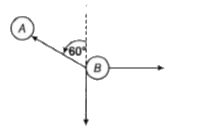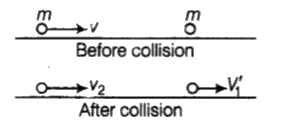Choose the most appropriate option.
Ball A moving at 12 m/s collides elastically with ball B, initially at rest as shown. If both balls have the same mass, then what is the final velocity of ball A?

(Given, sin60∘=0.87,cos60∘=0.5)
3m/s
6m/s
9m/s
12m/s
The correct Answer is:b
Similar Questions
A ball A of mass M collides elastically with a similar ball B at rest as shown in figure. Initially velocity of ball A is u m/s. After collision,

View SolutionA ball of mass m moving with a speed 2v0 collides head-on with an identical ball at rest. If e is the coefficient of restitution, then what will be the ratio of velocity of two balls after collision?
View Solution
Knowledge Check
A ball A of mass M collides elastically with a similar ball B at rest as shown in figure. Initially velocity of ball A is u m/s. After collision,
 ASpeed of ball B is u sinθBVelocity of ball A is usin2θˆi+usinθcosθˆjCSpeed of ball A is ucosθDVelocityofballBisu cos theta sin theta hati + u cos^2 theta hatj
ASpeed of ball B is u sinθBVelocity of ball A is usin2θˆi+usinθcosθˆjCSpeed of ball A is ucosθDVelocityofballBisu cos theta sin theta hati + u cos^2 theta hatjChoose the most appropriate option.
A ball of mass m moving at a speed v makes a head on collision with an identical ball at rest. The kinetic energy at the balls after the collision is 3/4th of the original. What is the coefficient of restitution?
 A1/√3B1/√2C√2D√3
A1/√3B1/√2C√2D√3A ball of mass m moving with a speed 2v0 collides head-on with an identical ball at rest. If e is the coefficient of restitution, then what will be the ratio of velocity of two balls after collision?
A1−e1+eBe−1e+1C1+e1−eDe+1e−1
A ball of mass m moving with a speed 2v0 collides head-on with an identical ball at rest. If e is the coefficient of restitution, then what will be the ratio of velocity of two balls after collision?
View SolutionA ball of mass M1 collides elastically and head on with another ball of mass M2 initially at rest . In which the following cases the transfer of momentum will be maximum?
View SolutionA ball of mass M moving with a velocity v collides perfectly inelastically with another ball of same mass but moving with a velocity v in the opposite direction. After collision
View SolutionA ball of mass moving with a velocity u collides head on with a ball B of mass m at rest. If the coefficient of restitution is e. the ratio of final velocity of B to the initial velocity of A is
View SolutionIf a ball A of mass mA=m2 moving along x-axis collides elastically with ball B of mass mB=m3 initially at rest and they move along x-axis. If initially velocity of ball A was v0. And initially de-broglie wavelength of ball A is λ0. Find change in debroglie wavelength δλ of ball A in terms of λ0
View Solution
